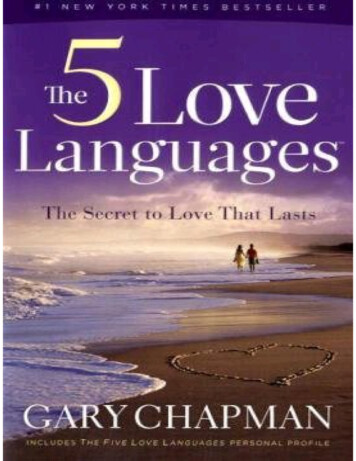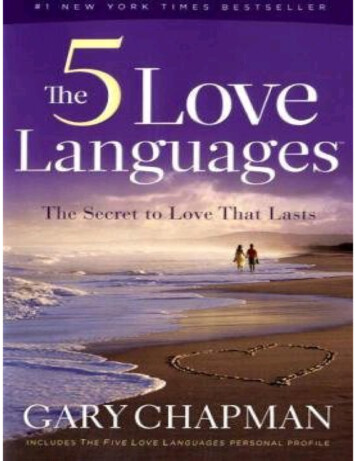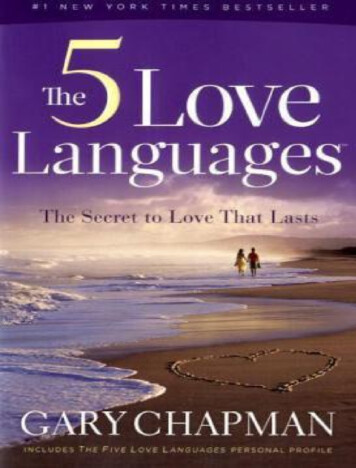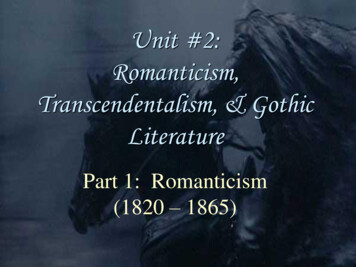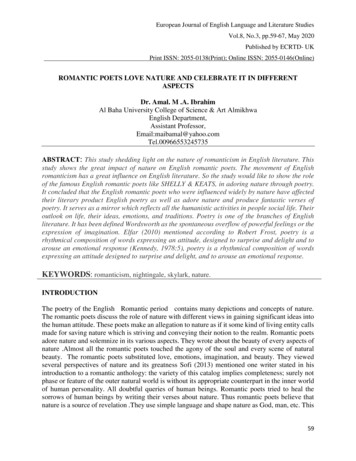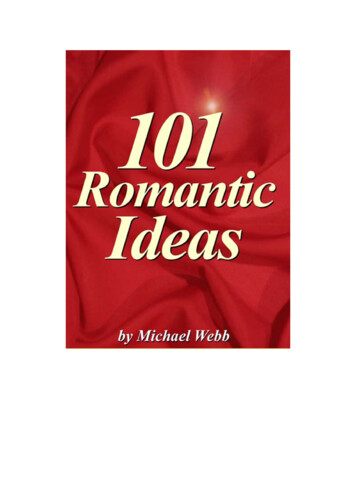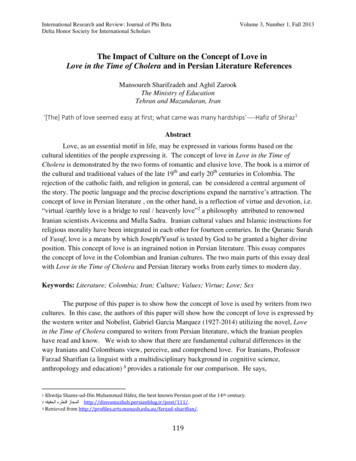
Transcription
Rethinking RomanticLove
Rethinking RomanticLoveDiscussions, Imaginariesand PracticesEdited byBegonya Enguix and Jordi Roca
Rethinking Romantic Love: Discussions, Imaginaries and PracticesEdited by Begonya Enguix and Jordi RocaThis book first published 2015Cambridge Scholars PublishingLady Stephenson Library, Newcastle upon Tyne, NE6 2PA, UKBritish Library Cataloguing in Publication DataA catalogue record for this book is available from the British LibraryCopyright 2015 by Begonya Enguix, Jordi Roca and contributorsAll rights for this book reserved. No part of this book may be reproduced,stored in a retrieval system, or transmitted, in any form or by any means,electronic, mechanical, photocopying, recording or otherwise, withoutthe prior permission of the copyright owner.ISBN (10): 1-4438-7645-3ISBN (13): 978-1-4438-7645-2
TABLE OF CONTENTSAcknowledgements . viiIntroduction . 1Love and its TransformationsJordi Roca and Begonya EnguixPart 1: Mobilities for LoveChapter One . 27“Is this true love?” Governing Love in the Context of Marriage MigrationMiriam GutekunstChapter Two . 45Latin American Women who Migrate for Love: Imagining European Menas Ideal PartnersYvonne RiañoChapter Three . 61Intimacies Turned On and Off: Spanish Men on Search of a ForeignPartner beyond the ScreenJordi Roca Girona, Verónica Anzil and Lídia Martínez FloresPart 2: Imaginaries of Love in Local ContextsChapter Four . 103Conceptions of the True Love and Love Magic among the Hungariansin GyimesJudit BalatonyiChapter Five . 129What it is to be Desired: Erotic Encounters and Ideals of Love amongPeople Who Practise Cross-Dressing in a Swinger Club in BarcelonaAlba Barbé i Serra
viTable of ContentsChapter Six . 161L Amavo Più Della Sua Vita: I Loved Her More Than Her LifeMarion Näser-LatherChapter Seven. 191El Amor Romántico (NO) MATA: Thinking through Romantic Loveand Men’s Engagement for Gender Equality in SpainKrizia NardiniPart 3: Writing(s) about LoveChapter Eight . 217Love Writing to Beloved Dead: The Continuation of the Loving Feelingbeyond DeathAntonella GrossiChapter Nine. 241Self-created Love Stories in Girls’ Romantic Culture: Historyand EvolutionEda KalmreChapter Ten . 271Love Ideals in Fifty Shades of GreyFrancesc Núñez and Begonya EnguixContributors . 297
ACKNOWLEDGEMENTSThe edition of this book has been made possible thanks to the support ofthe research project "Parejas mixtas residentes fuera de España: relacionesde género, dinámicas sociales y conexiones transnacionales" (SpanishNational R D I plan, Ministry of Economy and Competitivity CSO201233565). The editors are very grateful to all contributors and especially toCaitlin Trathen for the linguistic revision of the text.
INTRODUCTIONLOVE AND ITS TRANSFORMATIONSJORDI ROCA AND BEGONYA ENGUIXDismantling loveThere are two assumptions about love that most people make. The firstis that the feeling of love is universal and eternal and therefore does notvary significantly from place to place. The second is that love belongs topeoples' most intimate and private world and is almost impossible toapproach from a scientific, positivist perspective that understands emotionsmore as an impediment to knowing the world than as an essential part ofthis world (Russell 2003). These two assumptions, which we might alsocall prejudices may still often have two small, separate nuances. On theone hand, the universality of love is sometimes questioned in terms of theexistence of loving variants that, in relation to the Western hegemonicpattern, are considered "inferior" to it. Furthermore, the position of loveaffairs in the field of the intimate and the private and its subsequent allergyto scientific treatment does not prevent it from often being approached byscience, especially from some of the so called "hard sciences", such asbiology, evolutionary psychology, biochemistry or psychobiology. Thisscientific approach gives rise to a type of discussion that is allegedlyobjective about love, perceiving it as a universal emotion and revolvingaround concepts like "love chemistry". Concepts that, it is worth noting,seem to enjoy widespread popularity and that have helped to make someof the books that have emerged from this perspective reach the "bestsellers” lists1.This volume aims to rethink what we currently understand as romanticlove with various contributions. Different local contexts are presented(Hungary, Estonia, Spain, France, Italy, Latin America etc.) to pose questions1Some general references are Fisher (1992, 2004), Buss (1994), Morris (1967).
2Introductionabout what constitutes the romantic ideal in a transnational context ofglocalisation (Meyrowitz 2004). We consider whether love, as much as webelieve it to be the epitome of a single, unique and non-transferableexperience, is no more difficult to address scientifically than any othermultiple dimension of human experience.As evidenced by numerous historical studies (de Rougemont 1989;Stone 1977; Luhmann 1982; Giddens 1992; among others) and documented ina number of ethnographies (Mead 1935; Malinowski 1965; Rebhun 1999;Ahearn 2001; Kelsky 2001; Constable 2003; Padilla et al (eds.) 2012), theexperience of love is largely subject to the historical and cultural contextin which it operates. That is to say, although we cannot prove a priori thatthe way people felt historically and feel currently about love in differentplaces—how it is lived, how it is conceptualised, how it is expressed—isessentially identical or even similar, it does not preclude us fromrecognising that, as shown by the contributions to this volume, there aredimensions of the experience of love that are similar and have emerged asa more or less hegemonic global benchmark. It is common to refer to“romantic passion” as a paradigmatic example of universal feeling, asexpressed in the title of the work of W. Jankowiak (1995): RomanticPassion. A universal experience?2, which notes features—universal orquasi—of romantic loving passion, such as the desire for intimacy anddurability in a relationship, eroticism and idealisation of a loved one, andexclusivity and emotional dependency, among others. This has allowedsome authors to question the assertion, for example, that romantic love canonly develop in stratified societies with a leisure class and a rich literarytradition, or in small societies that promote mobility and individualdecision making. One of the most paradigmatic cases of this is the work ofFischer and Jankowiak (1992), which reports the existence of romanticlove in 146 of a sample of 166 cultures.For Jankowiak & Paladino (2008: 7) this and similar findings contradict“the popular idea that romantic love is essentially limited to, or the productof, Western Culture or is found only in smaller, highly mobile, and sociallyfragmented societies [.] [and] suggests that passionate love constitutes ahuman universal, or at the least a near universal”. However, the basicargument of this claim rests, as with any universal exercise, in thenaturalisation of the experience of love. From this position, it is not culturethat gives guidelines for infatuation but neurological orientation. Sincehumans are biologically similar, our way of loving will also be similar. Ifhumans were completely culturally constructed beings, passionate lovewould have no neurological basis (Jankowiak & Paladino 2008: 9). At this2See also Jankowiak and Fischer (1992) and Fisher (1992).
Love and its Transformations3point it might be useful to consider that it may well not have aneurological basis but is rather a neurological consequence. We must notconfuse love, or romantic love in particular, which is a particular way ofstructuring the loving feeling, with the universal feeling of love. Bothphenomena and the processes that trigger them have a universal andparticular inclination, universalised and unique. The desire to demonstratethe universality of one type or model of love (romantic love) by authorswho emphasise the bio-neurological basis of the loving feeling may wellalso be attempting to stigmatise, pathologise and/or de-legitimise otherpossible formulas of love and to establish, at the same time, a singlehegemonic and standardised model. In this volume, two contributionsclearly point to loving formulas that a priori fall outside the dogma.Barbé, in her chapter on erotic encounters, desire and ideals of love amongpeople who cross-dress at a swingers’ club in Barcelona presents andquestions the existence of nuclear ideals of love that create unknown(and/or stigmatised) peripheries. Grossi, through her analysis of graveletters, disembodies love and constructs it as an emotion that goes beyonddeath and creates a particular world of meaning for the living ones andtheir communities.For us, romantic love is associated with a particular historicalexperience of Western culture; to use it as a paradigm of a universalfeeling is the result of ethnocentric and ahistorical assumptions. Thisculturally located feeling has been generalised and universalised in greatmeasure by the mass media and in particular, by the film industry, whichsuggests this relationship model is unique and desirable. More prudent, inany case, might be the proposal of Fisher (1992), who uses the term“infatuation” to describe what for her and for us would be the universalexperience. And here we meet the other issue that we mentioned above:the specific historical reality that turns a particular model of loving into ahegemonic loving model on a global scale. A global ideology of love, akind of political economy of emotion (Scheper-Hughes 1992), includes thevalues, meanings and the same experience of emotion formed not only byculture but also by the power structures. Regarding this, it is worth notingthat all kinds of flows, people, capital, ideas, goods, etc. that characteriseglobalisation, do not circulate in a balanced way. So on the one hand, theforms, language and dialogues of Western love can easily appear, at leastsuperficially, around the world, but on the other hand the similarities thatwe find are the product not only of globalisation but also of specificeconomic and social transformations (Wardlow & Hirsch 2006: 2). Anexample of these globalised processes in the meaning of love can be foundin Núñez and Enguix’s contribution to this volume, an analysis of the explicit
4Introductionand hidden scripts of the Western ideals of romantic love and how E.L.James has put them down on paper in her best-selling trilogy Fifty Shadesof Grey.Loves that kill: Romantic LoveRomantic love, with its history rooted in the passionate love of ancientGreece, medieval courtly love and eighteenth century gallant occidentallove, is a device invented in Western Europe over the eighteenth andnineteenth centuries whose reach spread globally in an almost hegemonicway throughout the twentieth century, thanks largely to the invaluable helpof the “media” in the context of the emergence of the consumer society.This ideal is fundamentally linked to affective individualism andindividual freedom promoted by Romanticism. The resulting model formsthe basis of monogamous, emotionally involved partnerships, aconsequence of the so-called love match, as opposed to so-called marriageof interest or arranged marriage, or marriage of convenience—theprototype of the pre-industrial, agricultural, traditional, pre-modernsociety, or the old regime. In this old model, marriage and procreation ofthe family were highly integrated into community relations and kindred,and were not the centre of emotional and affective relations. Thefundamental principle of this type of marriage was the pursuit of socialreproduction, hence the emphasis on equality between spouses and thefundamental role played by parents in mate choice. Marriage was thestructure for basic preservation or for the increase in property ownership, arole that was to be progressively lost under capitalism. Thus, while themedieval and the modern age models would assume a fundamentalincompatibility between love and marriage, the nineteenth-centuryromantic ideology would assume its inseparability (Shumway 2003: 20).The emergence of romantic love, framed in the context of thebourgeoisie and industrial revolutions disrupted and revolutionised thebasis of the previous loving model. With the increasing dissolution of thesocial ties that structured traditional societies, in capitalist contexts peoplewere becoming increasingly individualised, that is, they saw themselves asunique, different from the others, and that too, as we said, was to favourthe perception of loving romance as something unique, personal and nottransferable. In turn, marriage, definitively and inseparably linked to love,became increasingly private, losing its social function and meaning andbecoming the answer to a new desire for intimacy. Moreover, with theappearance of a growing social fragmentation, marriage also became therefuge of genuine human relationships, emotions and affections.
Love and its Transformations5The idea of love as a necessary ingredient for marriage, and thedifference between marriage for love and marriage of convenience,structure the first section of this volume, dedicated to bi-nationalmarriages that imply mobility of one of the partners (Roca 2013). In theirrespective chapters, the contributors analyse mixed marriages andconceptions of love that transcend them from the perspectives of themembers of the couple (Riaño), of mediators—marriage agencies andonline platforms (Roca, Anzil and Martinez)—and of the officials whocertify that a marriage is not for interest, particularly in marriages betweencitizens of the first and third world (Gutekunst).Kalmre shows in her chapter that romantic love, to a great extent, hasgrown out of a body of romantic literature that was aimed primarily atwomen and that women have appropriated, reproduced and reconstructed.Her analysis is based on personal love stories created by Estonian girlsthat take the form of written texts (late twentieth century) or, morerecently, online blogs. Romantic love appears as one of the principlelegitimising bases of segregation of roles that has laid the foundations ofan industrialised society and is a reference for the future development ofthe consumer society. It is also a fundamental element for the meaning ofgender and gender relations. In their chapters, both Näser-Lather andNardini discuss the relationship between the ideals of romantic love andegalitarian gender relations. Näser-Lather, considering the religious,feminist and political discourses of contemporary Italy, addresses therelationship between them and violence against women. Nardini, in turn,analyses how a group of egalitarian men from Barcelona, Homes enDiàleg, question the ideals of romantic love and reconvert it into anegalitarian element that implies neither the possession of the feminine, northe subordination of women to men in heterosexual relationships.On the other hand, romantic love supposes that there is only oneperson in the world to whom one can join at all levels, which is idealisedin concepts such as your “Prince Charming” or metaphorical images ofyour “other half”. All this presupposes that you can establish a lastingemotional bond with someone based on intrinsic qualities (Bawin-Legros2004). So, romantic love rests on the idealisation of the object of love andthe mutual agreement of the couple to stay together forever, for better andfor worse. The contributions to the analysis of love written from abiologicist stance take the opportunity of making real lists of the psychophysiological characteristics of romantic love, such as an excess of energy,attention focused on the positive qualities of the partner and the belief thats/he is unique, motivation to pursue this ideal companion, loss of appetite,persistence, sweet caresses, kisses and licks, snuggling up to the beloved
6Introductionand coquettishly play, the growth of love in adversity, intrusive thoughts,the feeling of possession and dependence, the desire for union and fusionwith the beloved, a high sense of altruism, reordering of priorities infavour of the beloved, sexual attraction to the beloved, etc. (see forexample Fisher 2004 and Munch 2008). This catalogue is stated or impliedin most of the contributions to this volume and, as Balatonyi shows in hercase study on the conceptions of love among the Hungarians in Gyimes,the biological stance is internalised so much by lovers that love isunderstood as a sickness or as a magical possession. With suchassumptions, it is not surprising that elements such as possession,exclusivity, jealousy and sexual fidelity appear as evidence of love in theromantic rhetoric, which Vincent Cespedes calls “the formula ofgeneralised loving control that reproduces the traditional familybourgeoisie” (quoted by Bruckner 2011: 208). This formula is rigorouslyquestioned by Näser-Lather and Nardini. Additionally, in the context of aseries of demographic and economic factors that appear in the nineteenthcentury in Europe and North America linked to the process of theIndustrial Revolution (such as urbanisation, increased life expectancy, thedecline in infant mortality, the extension of schooling, the growth of wagelabour or low fertility), the romantic couple would also become the placeof pleasure and self-realisation rather than that of reproduction and socialobligations. Indeed, these marked changes in the nature of relationshipswill allow, for example, the couple to spend more time together withoutthe obligation to care for their children as well as an increasedinterdependence of married couples because individual emancipationwithin the extended family will no longer be possible. Similarly, as notedby Illouz (1997), these same changes will make it possible, in some cases,for women to become less economically dependent on their husbands andbring about a change of emphasis in marital expectations that willbecome—in theory—a shift from economic security to a focus onemotional satisfaction.Passion, durability and freedom of choice, as we have said, are thecornerstones of the new concept of love that emerged with Romanticismand the new ideal of love that it disseminated. Romantic love brought loveand freedom together for the first time. By including the desire forintimacy with your partner, it includes and excludes sexuality (Herrera2010: 321). That is to say, sexual desire and passionate (or romantic) love,go together with companionship, comfort and attachment. We mustemphasise the ideal components of this new pattern because itsprinciples—with the sky-rocketing expectations of conjugal union—differfrom (as well as shape) the real conditions of loving relationships.
Love and its Transformations7So, for example, the ideal of “love for your whole life” (still verycurrent) has, for decades, co-existed with the escalation in the divorce rateand a pattern of “serial monogamy”. As regards freedom of choice, its rolewas anchored increasingly to the world of fantasy, since the majortendency to homogamy has not suffered any decline over the last century.As rightly pointed out by Padilla et al. (2012), the irony is that even in the“developed world” the idea of a relationship based entirely on love isfictional. This is not only for the stubborn tendency of people to marrypeople similar to themselves, but also because money is important in arelationship (as evidenced by many divorce proceedings) and because theidea of conjugal affection contrasts with the data on extra-marital sex,which shows how sex outside of marriage is more prevalent than inside it,as happened in the pre-modernity.Loves that die and/or are reborn:going beyond or perfecting romantic loveThe distance between the romantic ideal and most loving practices,their contradictions and changes in all spheres since the emergence anddominance of romantic love in the eighteenth and nineteenth centurieshave fuelled the need to provide new insights and analysis on its validityand its transformations. Love is not immune to the specific socio-historicalcontext in which it occurs and, therefore, the contributions in this volumefocus on the analysis of specific cases. Similarly, and for the same reason,our framework for talking about love and its transformations are thetransformations in capitalism and the advent of post-modernism linked toglobalisation. However, globalisation does not have an impact with thesame intensity everywhere and post-modernity is not a universalphenomenon but it is linked mainly to the so-called “Western” society,with a strong mass culture, especially in urban environments. There arestill many places and many cultures, then, regardless of a post-modernismthat is fundamentally defined by two principle aspects, the superiority ofnew information and communication technologies, and consumption,which bring increasing flexibility, fragmentation or discontinuity (seeLyon 1994). In this volume, despite the variety of geographical contextsanalysed, we focus on the Western imaginaries of love.Among the most interesting and most referenced reflections, we havethe work of Giddens (1992: 63), who considers that romantic love will bereplaced by confluent love: a contingent active love, which sheds the ideaof eternity—“forever”—and exclusivity—“the one and only”—typical ofromantic love, to be founded more on reflexivity and emotional intimacy.
8IntroductionThis confluent love, however, goes hand in hand with another term putforward by Giddens (1992): the pure relationship, a relationship based onsexual and emotional equality, characterised by the fact that it isestablished by its own initiative and is only continued to the extent that itis judged by both parties to offer enough for each individual’s satisfaction.Durability is, therefore, subject to individual satisfaction. The purerelationship, pairs love with sexuality, equality and freedom, withreciprocal giving and receiving. Contemporary love is an attempt, in away, to reconcile conflicting desires, dialectical forces in conflict, such asthe desire for fusion (with consequent aspiration to eternal love,indivisible, free of lies) and the desire for individualisation (see Beck andBeck-Gernsheim 1995; Bruckner 2011), resulting in love “with right ofreturn” consisting of abandonment when the necessary dose of passion orcommunication is no longer given3.Giddens’ proposed model presents differentiating elements betweenromantic love and others that maintain a certain continuity with it.Durability is no longer a maxim of love, but the emotional involvement ofthe spouses. Emphasis is placed, on the other hand, on equality but -aswith sexual pleasure- it is linked to the couple unlike in romantic lovemodels. Eva Illouz (1998) considers the innocence of love as having beenlost, the “love affair” being the paradigm of the post-modern condition.While in Giddens’ approach eligibility and individuality seem to lead to acertain transcendence of the affair, Illouz’s proposal opts for what Béjar(1995) calls “the fascination of a distrascendentalised culture” based on anindividualistic logic whose central value is the self. Novelty is the majorsource of satisfaction, and therefore the affair stands as an attempt to retainand repeat, compulsively, the primordial experience of novelty in contrastto the romantic narrative of great love, which is theological, absolute and asingle thought. The affair provides a dual purpose: the freedom to choosebetween different partners according to our preferences on the one hand;and the transitional and renewable pleasure on the other. And, indeed, asBauman (2003) notes, the accumulation to which love in the consumersociety tends towards will eventually represent a type of ability that can belearned and that will reach a level of expertise according to the number ofexperiences.3For Bawin-Legros (2004: 247) this attempt to reconcile conflicting desires wouldbe particularly middle-class, since the lower classes adopt a model where a desire forfusion within couples predominates within the framework of the dominantconception of the family as a refuge.
Love and its Transformations9All this, Illouz (1998) says, is simply the post-modern expression ofthe desire of pure sensation that produces unconnected episodes and afragmentation of the experience of love into separate emotional units,radically altering the romantic and sexual pre-modern sensibility. The ideaof an affair connects seamlessly with Bawin-Legros' idea that we aretourists in our own private territory (2004: 242), within a realm ofindividualism that gives us an increasing ability to choose when, whereand with whom to have sex and in which forgetting is more importantthan the memory. It is also linked with Bauman’s approach (2003) whichis based on a fear of establishing lasting relationships beyond mereconnections. That is something that Illouz (2012) herself goes into moredeeply in terms of fear of commitment, which carries the new architectureof the loving choices that one makes, particularly evident in the maledetachment. A detachment that the group analysed by Nardini questionsas the only male referent.In any case, although the emphasis on fragmentation and individualisationof the loving experience can be successful, it is no less true that the wishesof the many and possibly heartfelt pressures held by a part of thepopulation in terms of acquisition and/or preservation of romanticrelationships, “traditional” (read “institutionalised perennial marriage”)relationships are still very present, and most of the contributions to thisvolume are an example.The pattern of successive marriages, a mainstream reality, does notpreclude or is inconsistent with the fact that large sections of thepopulation express a desire to get married “for life” or, at least, with a highdegree of stability, as a stronghold of traditional references within theframework of what has been given the label neo-romanticism.Similarly, the foundation of the affair in “pristine purity” of one’sdesire and satisfaction can be ahistorical and naive for not consideringeither the social situation of the actors or the context in which theexistence of conflicts develop, often related to power and inequality. Theprime focus in choice also easily hides the existence of social constraints(Holmes 2004: 256), some that build relationships as socially legitimate incontrast to other relationships that are invisibilised (Barbé) or considered“impure” (Balatonyi).As with the romantic ideal, romantic relationships are embedded in thetension between idealisation and “real” divergent practices (Jamieson1998, 1999; Smart & Shipman 2004). For example, the economicdimensions of the couple are a paradigmatic example of the danger ofexcessive or exclusive attention to the couple’s emotional inclination andideal of romantic love. Viviana Zelizer (2005) has carefully pointed out
10Introductionsome of these dimensions, which are beginning to become relevant in theearly stages of romantic relationships and dating, which is supposedly themore passionate and selfless phase of the process.This author notes how dating has pivoted, and continues to pivot,around the man’s payment for most of the entertainment expenses.Regarding that, Roca, Anzil and Martinez show us clearly how in theprocess of looking for a transnational partner over the Internet it is the menwho pay. This is not a minor detail, since it may symbolise largely thenature of the relationship in terms of gender4. Riaño shows us too howLatin American women are giving up their careers in order to strengthenthe careers of their Swiss husbands, thus becoming financially dependenton them. That is not to mention the economic inequality and statusbetween billionaire Christian Grey and the student Anastasia Steele inFifty Shades of Grey, analysed by Núñez and Enguix.According to Zelizer, courtship also implies a series of economictransactions of various kinds: entertainment, meals, gifts, ceremonies,festivals, celebrations, preparation and fulfilment of the wedding, a newhome, furniture, tableware, household items, etc. which makes herconclude that “from dating to the brink of marriage, therefore, themingling of courtship and economic transactions occurs continuously”(Zelizer 2005: 108). This also prompts her to say that “despite the newterminology and practices, some residues of the old system remain” (2005:116).This characteristic landscape of the urban middle-class in America—and in many other countries—cannot be generalised because there areethnic, racial, class and religious differences in dating, for example(Zelizer 2005: 115 ), but it is the scenario that, in light of the contributionsto this volume, seems to be hegemonic.One of the transforming el
Rethinking Romantic Love: Discussions, Imaginaries and Practices Edited by Begonya Enguix and Jordi Roca This book first published 2015 Cambridge Scholars Publishing Lady Stephenson Library, Newcastle upon Tyne, NE6 2PA, UK British Library Cataloguing in Publication Data A catalogue record for this book is available from the British Library
